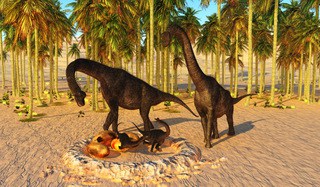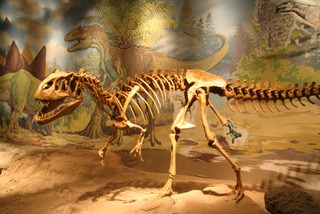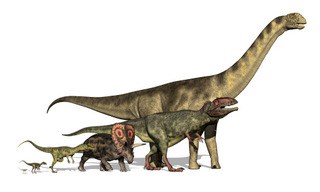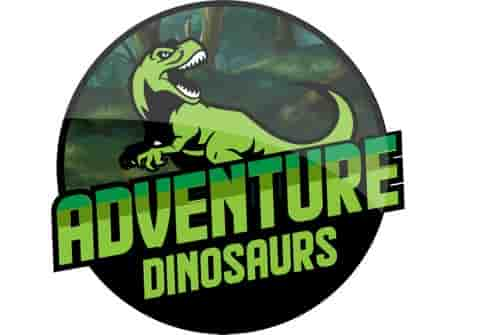I love watching dinosaur movies, and although dinosaurs vary in many ways, I noticed that they do have common traits! After repeatedly seeing them in films, I tried listing down their obvious similarities and felt like they must also be similar in ways that are not evident. So I did some research and found out that dinosaurs have more common characteristics than I initially expected.
What do all dinosaurs have in common? The most prominent 11 similarities are:
● They are vertebrates
● Have strong knee and ankle joints
● Have two holes behind each eye socket
● A hole between the eye socket and the nostril
● Are either lizard-hipped or bird-hipped
● Have a hole in their hip sockets
● Have straight back legs
● Have textured skin
● Have a fast growth rate
● Stayed mostly on land
● They laid eggs to reproduce
Some of the common characteristics of all dinosaurs are present in their skeletal structures, while some are physically obvious traits.

If you find it hard to distinguish dinosaurs from other prehistoric reptiles, this article is for you. You will read about the common characteristics of dinosaurs in both their skeletal and physical aspects. Besides this, you’ll also discover the closest living relative of the extinct dinosaurs and why they are all believed to have laid eggs.
There is a lot of species variation in dinosaurs. The fossil evidence we have of dinosaurs spans millions of years, from the Triassic period, Jurassic period, and the Cretaceous period up until the mass extinction event. There were many evolutionary changes during these millions of years, and paleontologists are piecing together the species variation.
Sauropod dinosaurs, for instance, were different in size and shape from the duck-billed hadrosaurs. Or take the carnivorous predators such as T. Rex and compare them to the armored herbivores like Ankylosaurus or Stegosaurus. Even with the species variation, paleontologists have determined that there are common characteristics found in dinosaurs’ fossil records.

Common Skeletal Characteristics of Dinosaurs
Other prehistoric reptiles that existed together with dinosaurs are usually mistaken as dinosaurs too. According to our scientists and dinosaurs experts, the common characteristics of dinosaurs listed here will provide you a clear identification of what dinosaurs are supposed to be.
Dinosaur fossils, mostly from their bones, play an important role in gathering information about dinosaurs. From these fossils, similar skeletal structures are also observed to be common for all dinosaurs.
Vertebrates have a skeletal structure attached to a backbone that surrounds and protects a nerve cord. The dinosaurs are all vertebrates with up to 25 vertebrae in their backbones. During the Mesozoic Era, especially the Jurassic and Cretaceous periods, dinosaurs were the ruling vertebrates in their land. The fossil record shows that these dinosaur vertebrates often had an “S-shaped” neck, and this s-shaped neck is seen, for instance, in the giant sauropod fossil skeletons. (Source)
Strong Knee and Ankle Joints
Aside from their size, dinosaurs are also known for their strength. Their bone structure is a factor that made them strong. Unlike most reptiles today, dinosaurs’ knees look like simple hinges, making them more stable. Their ankle bones are not the peg-and-socket joint, but rather, their ankle bones are attached to their shin bones. This ankle structure also gave all dinosaurs stability and strength suitable for their enormous bodies.
The Skull – Holes Between the Sockets
Dinosaurs Have Two Holes Behind Each Eye Socket
Every dinosaur’s skull discovered has two holes behind each of its eye sockets, and this characteristic makes dinosaurs diapsids. These holes, located above and behind the eye sockets, seem like two arches in their eye sockets. The purpose of these holes is for their large jaw muscles to pass through to attach to the top part of their skulls. It allowed dinosaurs to open their jaws widely and also shut them forcefully.
YouTube Video Showing Dinosaur Skulls – Notice the Holes No Matter the Size or Type of Dinosaur
They Also Have A Hole Between The Eye Sockets And Nostril
Dinosaurs seem to have many holes in their skulls because they also have another hole between their eye sockets and nostrils. This hole is called the antorbital fenestra, present in all archosaurs, including the birds and crocodilians. The purpose of this hole is to help in cooling the inside of their large heads. Antorbital fenestra connects an air chamber to the dinosaur’s respiratory system. It let dinosaurs grow as big as they were without overheating their brains due to their huge bodies’ intense heat.
The Importance of the Hip – Lizard-Hipped or Bird-Hipped
The difference in the dinosaur’s hip structure is so distinct that all theropod dinosaurs can be categorized into two orders: the saurischian (“lizard-hipped”) and ornithischian (“bird-hipped”) dinosaurs. Saurischian dinosaurs are similar to what lizards are today. They have three hip bones that protrude in different directions. Both herbivorous and carnivorous dinosaurs are part of this order, and they were armored dinosaurs. There were also horned dinosaurs that were part of this group. On the other hand, Ornithischian dinosaurs are similar to modern birds, and they have two forward-projecting hip bones parallel to the third bone. Only herbivorous dinosaurs belong to this order. (Source)
The herbivore dinosaurs’ group includes the horned dinosaurs, the armored dinosaurs, the sauropods, and the duck-billed dinosaurs. I wrote an article about herbivore dinosaurs. If you are interested, you can find it here – Herbivore Dinosaurs – What’s So Cool About Them?
They Also Have A Hole in Their Hip Sockets
Holes are not only found in dinosaur skulls but also in their hips. Usually, reptiles only have a dimple in their hip sockets, but an entire hole is present in their hip sockets for true dinosaurs. It helped dinosaurs position their legs directly under their bodies and not branched out to the sides like the crocodiles. All these previously mentioned holes greatly helped in reducing the weight of huge and heavy dinosaur.
Holes or extra space in the hip areas has confused in the past. The Stegosaurus, an armored dinosaur with bony plates running along its backbone and ending in a giant spiked tail, had large space at the end of the spinal cord. Paleontologists initially suggested that this space could be for a second brain.
However, this assumption has been corrected as more fossils have been found, and scientists know that dinosaurs had only one brain, despite the extra space near the hip. If you are interested to know more about dinosaurs and their brain size and intelligence, check out my article Did Dinosaurs Have Two Brains? The Smartest Dinosaurs Listed!
Common Physical Characteristics of All Dinosaurs
Just like what we can observe in movies, dinosaurs have obvious physical similarities too.
Science uses phylogenetic analysis, taking evolutionary relationships and comparing them with one another, to classify and group similar animals such as dinosaurs. This analysis can determine the closest relative to dinosaurs and classify groups of extinct theropods species like the Tyrannosaurus Rex from North America.

Let’s get started by listing the main common physical characteristics of dinosaurs, starting with their hind limbs.
Dinosaurs Have Straight Back Legs
Despite their huge size, walking and running seem easier for dinosaurs than other reptiles like crocodiles and lizards. It is because they have straight back legs that are perpendicular to their bodies, which results in their upright stance. Another advantage of this physical characteristic is that no matter how heavy any dinosaur is, its weight is better supported.
It also gave them more superiority among other creatures because their energy is spent more on survival and reproduction. Other reptiles commonly mistaken as dinosaurs like the ichthyosaurs, plesiosaurs, and mosasaurs do not have this characteristic.
They Have Textured Skin
The dinosaur skin remains a huge question for many scientists, but one thing’s common among their discoveries, dinosaurs did not have smooth and soft skin similar to ours. There are discoveries of dinosaur fossils that are feathered, which make them similar to our modern birds. These feathered dinosaurs are still unlikely to have the ability to fly, but they use feathers either for communication (fights or courtship) or for nesting (covering the nest).
If not feathered, some dinosaurs are believed to have feather-like structures such as protofeathers (modified scales), bristles, and filaments in parts of their bodies. Some fossil evidence also suggests that they had scaly skin, which is true for the herbivorous dinosaurs. If not scaly skin, fossilized skin impressions also suggest that some dinosaurs had bumpy skin.
Fast Growth Rate
Dinosaurs hatching from eggs can take up to 6 months but once hatched, they grow fast. Studies related to fossilized bones of young dinos indicate that they had a fast growth rate. Huge dinosaurs like the sauropods had a maximum growth rate of 14 kilograms per day (Source)
And that is about as fast as a blue whale, the fastest-growing mammal now. Smaller dinosaurs had a minimum growth rate of about twice the growth rate of modern reptiles.
Stayed on Land
All known dinosaurs are amniotes, which enables them to survive anywhere on dry land. Amniotes are animals whose eggs are equipped with special membranes to protect babies. It is an adaptation suitable for laying eggs in a dry environment. Dinosaurs as land dwellers make them distinct from pterosaurs, which are often mistaken as flying dinosaurs. If you want to read more about pterosaurs, I wrote an article that covers the classification and phylogeny as well as covering the most common species – check it out here – Flying Dinosaur Types – What Were They?
Dinosaurs Laid Eggs Like Their Common Ancestors Birds and Reptiles
So far, all hard evidence, dinosaur fossils, and the places where their fossil remains were found point to theropod dinosaurs laying eggs. Although no one is entirely sure, laying eggs is the only proven reproduction method for all known dinosaurs.
You probably heard this before that modern birds can be referred to as dinosaurs, close relatives. And this is true. There is a definite link between birds. Despite the difference in hip structure, most of the evidence discovered points to birds having evolved from the saurischian dinosaurs or the lizard-hipped dinosaurs.
————————————————————————————————
Related Dinosaur Articles You Might Also Be Interested In:
Did Dinosaurs Have Two Brains? The Smartest Dinosaurs Listed!
How Much Is a Real Dinosaur Egg Worth [UPDATED 2021]
What Are Long Neck Dinosaurs (Types, Size, List)?
————————————————————————————————
Why Scientists Think All Dinosaurs Laid Eggs
Lots of fossilized dinosaur eggs are unearthed, which are mostly from the gigantic sauropods, carnivorous theropods, and the duck-billed hadrosaurs. The theropods laid elongated eggs while the non-theropods, such as the hadrosaurs and sauropods, laid spherical eggs.
Interestingly, the nesting grounds of hadrosaurs in Montana and the titanosaur egg clutches (nests) found in Argentina gave rise to speculation that some dinosaurs lay eggs in a colony. Still, they took care of their young and protected the nesting grounds against predators.
These dinosaur fossil eggs can be either hard-shelled or soft-shelled and can also be shaped differently. Another evidence of dinosaurs laying eggs is the discovery of various nesting sites and colonies. Aside from these, the living relatives of dinosaurs such as birds and reptiles all laid eggs. Birds are considered direct descendants of dinosaurs, while reptiles have common ancestors with dinosaurs.
Fossil eggs have been found all over the world and on all continents. Dinosaur eggs have been found individually, in clutches, and even with dinosaur embryos intact. If you want to read more about dinosaur eggs, check out my articles How Much Is a Real Dinosaur Egg Worth and Do All Dinosaurs Hatch From Eggs?
Modern Reptiles and Dinosaurs Share Common Ancestors
Aside from birds, other reptiles are related to dinosaurs too. Both under the Reptilia Class, modern reptiles and dinosaurs share common ancestors. Modern alligators and crocodiles’ physical appearance still looks similar to their ancient ancestors that existed together with the dinosaurs. Turtles are also related to dinosaurs as they are one of the earliest reptiles still alive today. All remaining species of sea turtles have ancient origins that coexisted with dinosaurs. The most remarkable ancient turtle is the Archelon, which was 4 meters in length and 5 meters in width and is related to the leatherback turtles alive today.
Birds Are Direct Descendants of Dinosaurs
Although dinosaurs cannot fly, birds and dinosaurs still have several similarities. There is compelling direct evidence. For instance, birds have the same simple hinge knee joints as all dinosaurs. They are also archosaurs, which means that they have a hole between the eye sockets and nostrils. Just like dinosaurs, birds have straight legs directly underneath their bodies. Birds also have textured skin because of their feathers. Lastly, birds lay eggs that also contain the amniotic membrane.
If you are interested to know what other animals are closely related to dinosaurs, check out my article The 9 Closest Living Things to Dinosaurs.
The evolution of flying reptiles, dinosaurs, and birds took millions of years. The cool thing is that modern classification and phylogenetic analyses help us see the similarities between birds and dinosaurs. Unfortunately, it also shows us some big gaps between ancient birds and flying reptiles compared to modern birds.
Final Thoughts
Every dinosaur is indeed similar to each other more than what they seem.
Knowing all of these, I think you can now better distinguish true dinosaurs from among all the prehistoric reptiles.
There are still a few nagging questions that will take other articles to cover, namely whether all dinosaurs have feathers and if all dinosaurs laid eggs and nursed their young, but I will save this for future articles website.
It’s cool to use your knowledge. Whenever I can see real dinosaur skeletons or replicas in museums, it’s interesting to go down this checklist of common traits to see if all of them are there, especially the skull and hip traits. Of course, some of the fossils are not in the best condition and may be incomplete, but in my view, it gives me a better understanding of how all these dinosaurs are connected. And the connection is there in modern-day animals too!
